NURSING CARE PLAN: Albert Clarke - NURS2004 Assignment, COPD Care
VerifiedAdded on 2022/08/10
|11
|2910
|22
Report
AI Summary
This assignment presents a comprehensive nursing care plan for Albert Clarke, a 72-year-old male admitted with an acute exacerbation of Chronic Obstructive Pulmonary Disease (COPD) and community-acquired pneumonia. The care plan focuses on two nursing diagnoses: ineffective breathing pattern and ineffective airway clearance. The report details the assessment process, including vital signs, breath sounds, and arterial blood gas analysis. It outlines diagnostic findings, such as low oxygen saturation and thick sputum production. The planning phase establishes goals like restoring normal breathing and improving oxygenation. Implementation strategies include positioning, fluid intake, medication administration (corticosteroids, bronchodilators, and antibiotics), and oxygen therapy. The evaluation section assesses the effectiveness of interventions based on patient outcomes like improved breathing and arterial blood gas levels. The report also discusses the roles of a multidisciplinary healthcare team, including pulmonologists, respiratory nurses, and COPD educators, along with ethical and legal considerations in geriatric nursing care. The conclusion emphasizes the importance of proper assessments and interventions for effective COPD management.
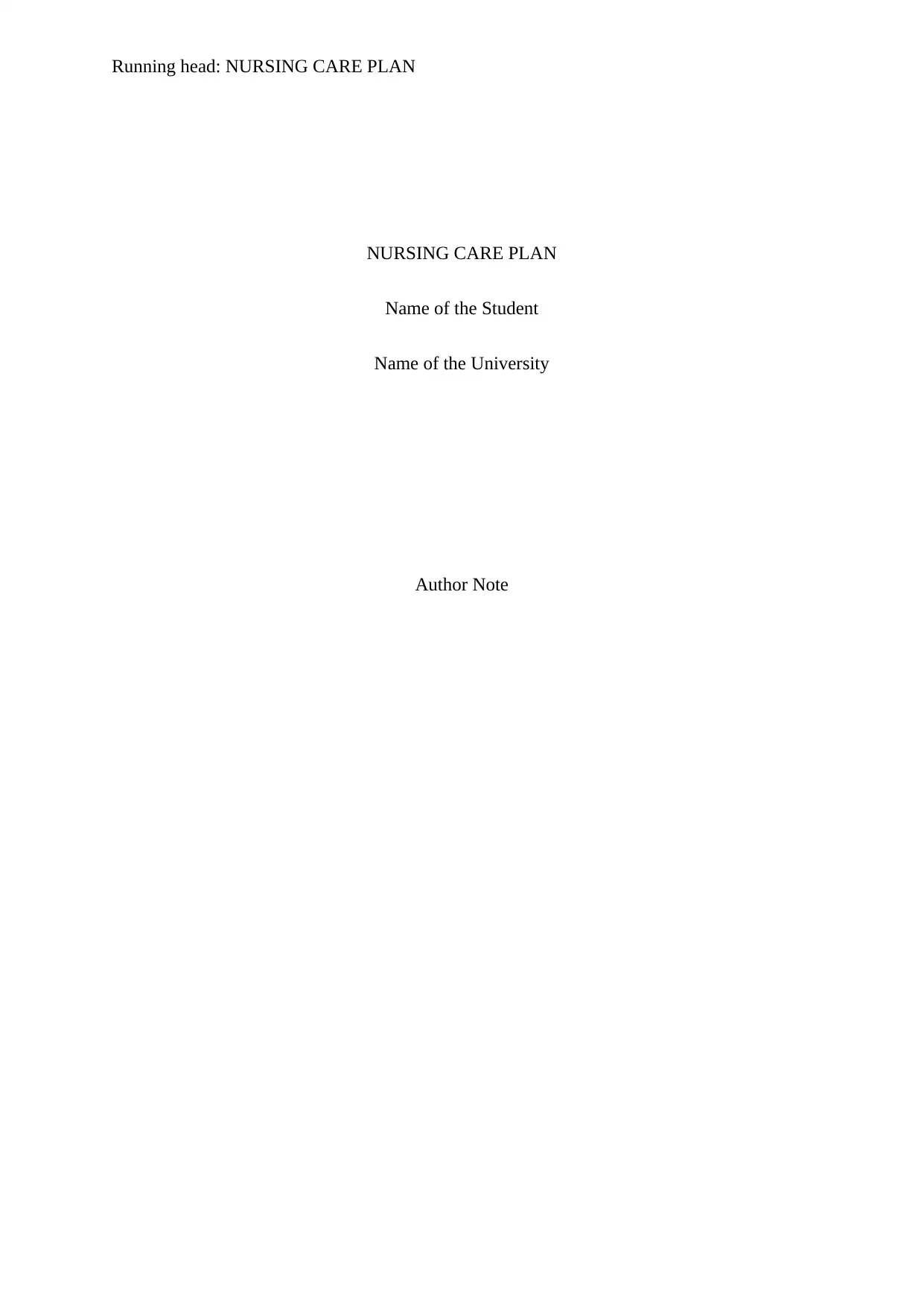
Running head: NURSING CARE PLAN
NURSING CARE PLAN
Name of the Student
Name of the University
Author Note
NURSING CARE PLAN
Name of the Student
Name of the University
Author Note
Paraphrase This Document
Need a fresh take? Get an instant paraphrase of this document with our AI Paraphraser
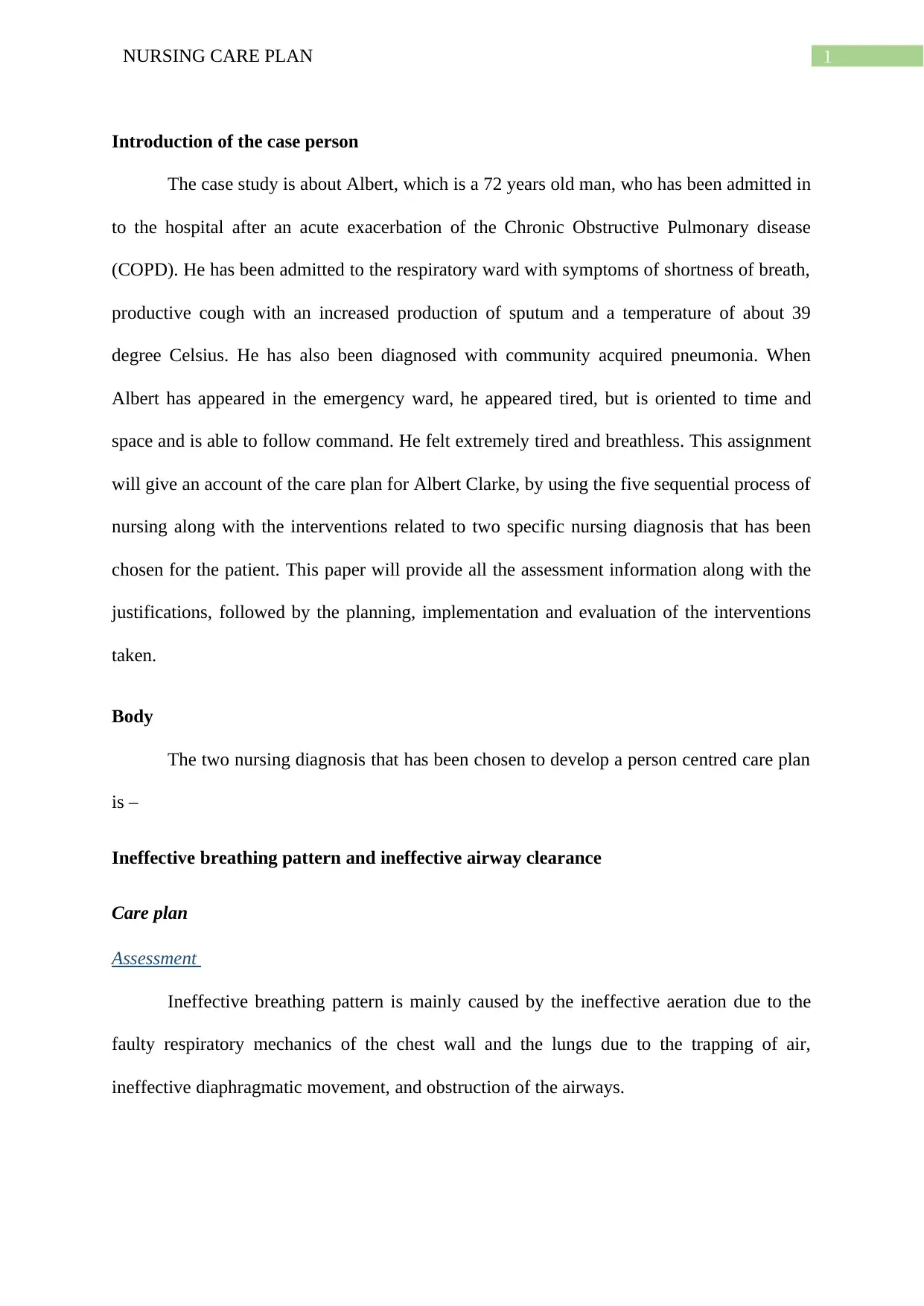
1NURSING CARE PLAN
Introduction of the case person
The case study is about Albert, which is a 72 years old man, who has been admitted in
to the hospital after an acute exacerbation of the Chronic Obstructive Pulmonary disease
(COPD). He has been admitted to the respiratory ward with symptoms of shortness of breath,
productive cough with an increased production of sputum and a temperature of about 39
degree Celsius. He has also been diagnosed with community acquired pneumonia. When
Albert has appeared in the emergency ward, he appeared tired, but is oriented to time and
space and is able to follow command. He felt extremely tired and breathless. This assignment
will give an account of the care plan for Albert Clarke, by using the five sequential process of
nursing along with the interventions related to two specific nursing diagnosis that has been
chosen for the patient. This paper will provide all the assessment information along with the
justifications, followed by the planning, implementation and evaluation of the interventions
taken.
Body
The two nursing diagnosis that has been chosen to develop a person centred care plan
is –
Ineffective breathing pattern and ineffective airway clearance
Care plan
Assessment
Ineffective breathing pattern is mainly caused by the ineffective aeration due to the
faulty respiratory mechanics of the chest wall and the lungs due to the trapping of air,
ineffective diaphragmatic movement, and obstruction of the airways.
Introduction of the case person
The case study is about Albert, which is a 72 years old man, who has been admitted in
to the hospital after an acute exacerbation of the Chronic Obstructive Pulmonary disease
(COPD). He has been admitted to the respiratory ward with symptoms of shortness of breath,
productive cough with an increased production of sputum and a temperature of about 39
degree Celsius. He has also been diagnosed with community acquired pneumonia. When
Albert has appeared in the emergency ward, he appeared tired, but is oriented to time and
space and is able to follow command. He felt extremely tired and breathless. This assignment
will give an account of the care plan for Albert Clarke, by using the five sequential process of
nursing along with the interventions related to two specific nursing diagnosis that has been
chosen for the patient. This paper will provide all the assessment information along with the
justifications, followed by the planning, implementation and evaluation of the interventions
taken.
Body
The two nursing diagnosis that has been chosen to develop a person centred care plan
is –
Ineffective breathing pattern and ineffective airway clearance
Care plan
Assessment
Ineffective breathing pattern is mainly caused by the ineffective aeration due to the
faulty respiratory mechanics of the chest wall and the lungs due to the trapping of air,
ineffective diaphragmatic movement, and obstruction of the airways.
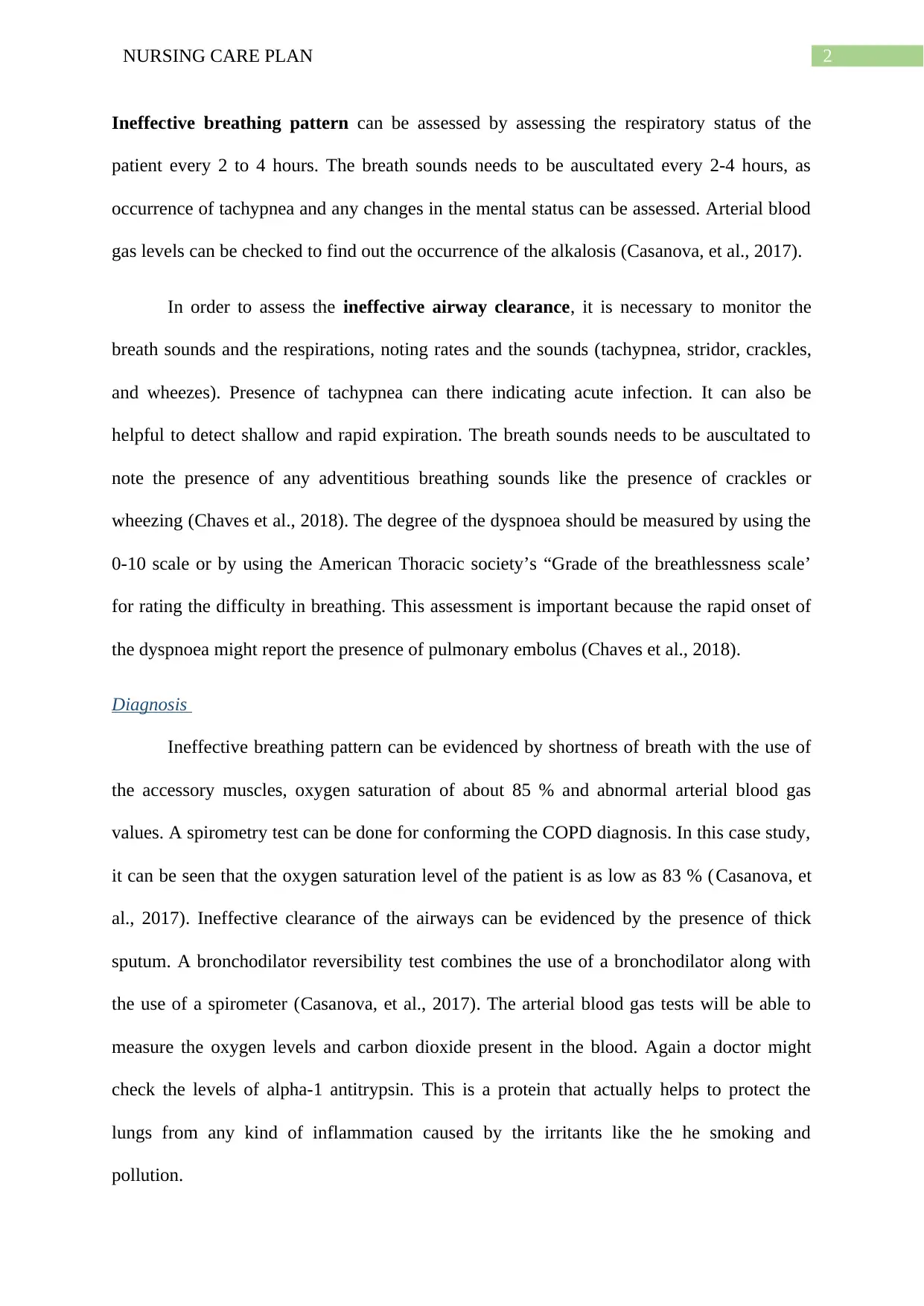
2NURSING CARE PLAN
Ineffective breathing pattern can be assessed by assessing the respiratory status of the
patient every 2 to 4 hours. The breath sounds needs to be auscultated every 2-4 hours, as
occurrence of tachypnea and any changes in the mental status can be assessed. Arterial blood
gas levels can be checked to find out the occurrence of the alkalosis (Casanova, et al., 2017).
In order to assess the ineffective airway clearance, it is necessary to monitor the
breath sounds and the respirations, noting rates and the sounds (tachypnea, stridor, crackles,
and wheezes). Presence of tachypnea can there indicating acute infection. It can also be
helpful to detect shallow and rapid expiration. The breath sounds needs to be auscultated to
note the presence of any adventitious breathing sounds like the presence of crackles or
wheezing (Chaves et al., 2018). The degree of the dyspnoea should be measured by using the
0-10 scale or by using the American Thoracic society’s “Grade of the breathlessness scale’
for rating the difficulty in breathing. This assessment is important because the rapid onset of
the dyspnoea might report the presence of pulmonary embolus (Chaves et al., 2018).
Diagnosis
Ineffective breathing pattern can be evidenced by shortness of breath with the use of
the accessory muscles, oxygen saturation of about 85 % and abnormal arterial blood gas
values. A spirometry test can be done for conforming the COPD diagnosis. In this case study,
it can be seen that the oxygen saturation level of the patient is as low as 83 % (Casanova, et
al., 2017). Ineffective clearance of the airways can be evidenced by the presence of thick
sputum. A bronchodilator reversibility test combines the use of a bronchodilator along with
the use of a spirometer (Casanova, et al., 2017). The arterial blood gas tests will be able to
measure the oxygen levels and carbon dioxide present in the blood. Again a doctor might
check the levels of alpha-1 antitrypsin. This is a protein that actually helps to protect the
lungs from any kind of inflammation caused by the irritants like the he smoking and
pollution.
Ineffective breathing pattern can be assessed by assessing the respiratory status of the
patient every 2 to 4 hours. The breath sounds needs to be auscultated every 2-4 hours, as
occurrence of tachypnea and any changes in the mental status can be assessed. Arterial blood
gas levels can be checked to find out the occurrence of the alkalosis (Casanova, et al., 2017).
In order to assess the ineffective airway clearance, it is necessary to monitor the
breath sounds and the respirations, noting rates and the sounds (tachypnea, stridor, crackles,
and wheezes). Presence of tachypnea can there indicating acute infection. It can also be
helpful to detect shallow and rapid expiration. The breath sounds needs to be auscultated to
note the presence of any adventitious breathing sounds like the presence of crackles or
wheezing (Chaves et al., 2018). The degree of the dyspnoea should be measured by using the
0-10 scale or by using the American Thoracic society’s “Grade of the breathlessness scale’
for rating the difficulty in breathing. This assessment is important because the rapid onset of
the dyspnoea might report the presence of pulmonary embolus (Chaves et al., 2018).
Diagnosis
Ineffective breathing pattern can be evidenced by shortness of breath with the use of
the accessory muscles, oxygen saturation of about 85 % and abnormal arterial blood gas
values. A spirometry test can be done for conforming the COPD diagnosis. In this case study,
it can be seen that the oxygen saturation level of the patient is as low as 83 % (Casanova, et
al., 2017). Ineffective clearance of the airways can be evidenced by the presence of thick
sputum. A bronchodilator reversibility test combines the use of a bronchodilator along with
the use of a spirometer (Casanova, et al., 2017). The arterial blood gas tests will be able to
measure the oxygen levels and carbon dioxide present in the blood. Again a doctor might
check the levels of alpha-1 antitrypsin. This is a protein that actually helps to protect the
lungs from any kind of inflammation caused by the irritants like the he smoking and
pollution.
⊘ This is a preview!⊘
Do you want full access?
Subscribe today to unlock all pages.

Trusted by 1+ million students worldwide
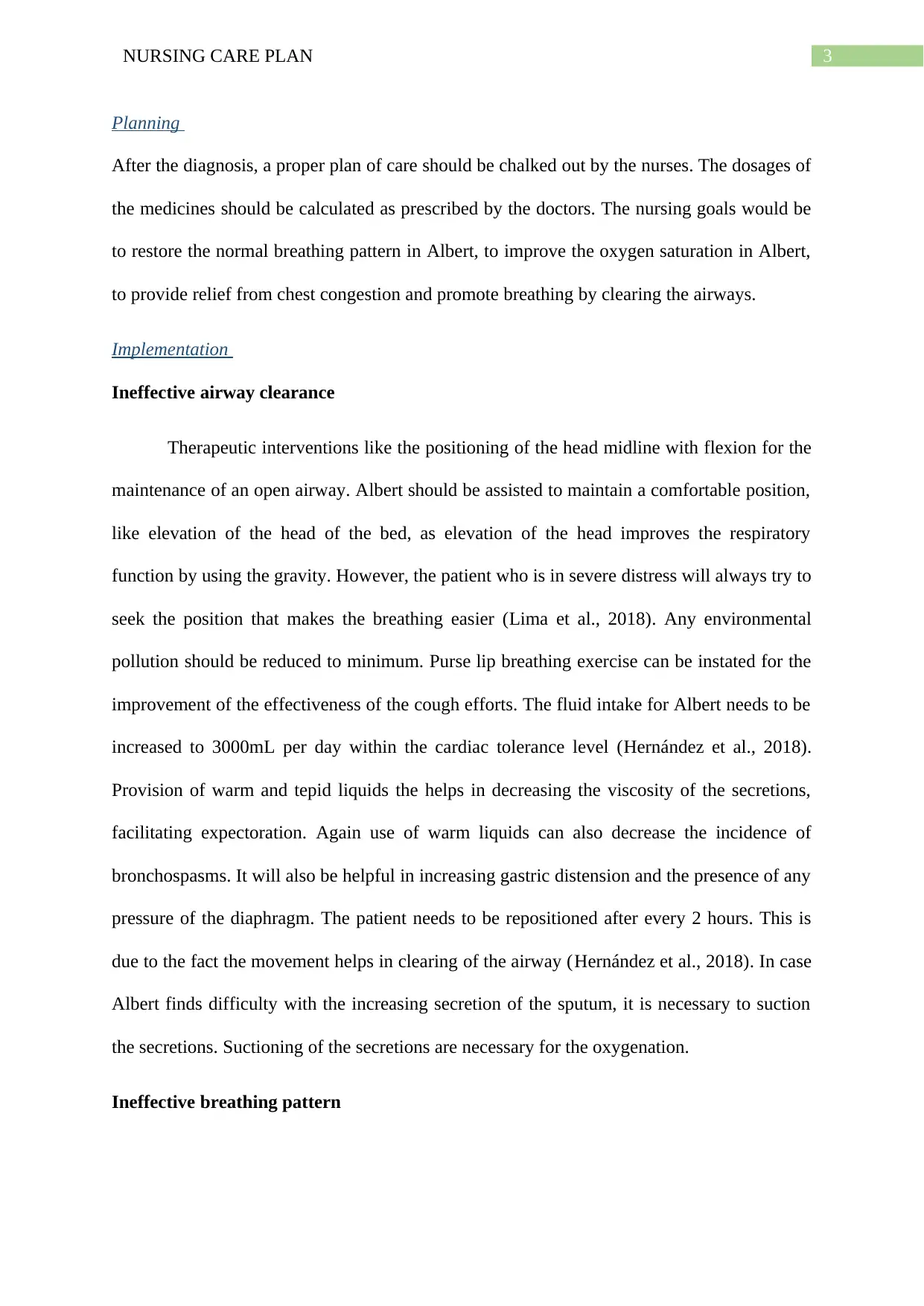
3NURSING CARE PLAN
Planning
After the diagnosis, a proper plan of care should be chalked out by the nurses. The dosages of
the medicines should be calculated as prescribed by the doctors. The nursing goals would be
to restore the normal breathing pattern in Albert, to improve the oxygen saturation in Albert,
to provide relief from chest congestion and promote breathing by clearing the airways.
Implementation
Ineffective airway clearance
Therapeutic interventions like the positioning of the head midline with flexion for the
maintenance of an open airway. Albert should be assisted to maintain a comfortable position,
like elevation of the head of the bed, as elevation of the head improves the respiratory
function by using the gravity. However, the patient who is in severe distress will always try to
seek the position that makes the breathing easier (Lima et al., 2018). Any environmental
pollution should be reduced to minimum. Purse lip breathing exercise can be instated for the
improvement of the effectiveness of the cough efforts. The fluid intake for Albert needs to be
increased to 3000mL per day within the cardiac tolerance level (Hernández et al., 2018).
Provision of warm and tepid liquids the helps in decreasing the viscosity of the secretions,
facilitating expectoration. Again use of warm liquids can also decrease the incidence of
bronchospasms. It will also be helpful in increasing gastric distension and the presence of any
pressure of the diaphragm. The patient needs to be repositioned after every 2 hours. This is
due to the fact the movement helps in clearing of the airway (Hernández et al., 2018). In case
Albert finds difficulty with the increasing secretion of the sputum, it is necessary to suction
the secretions. Suctioning of the secretions are necessary for the oxygenation.
Ineffective breathing pattern
Planning
After the diagnosis, a proper plan of care should be chalked out by the nurses. The dosages of
the medicines should be calculated as prescribed by the doctors. The nursing goals would be
to restore the normal breathing pattern in Albert, to improve the oxygen saturation in Albert,
to provide relief from chest congestion and promote breathing by clearing the airways.
Implementation
Ineffective airway clearance
Therapeutic interventions like the positioning of the head midline with flexion for the
maintenance of an open airway. Albert should be assisted to maintain a comfortable position,
like elevation of the head of the bed, as elevation of the head improves the respiratory
function by using the gravity. However, the patient who is in severe distress will always try to
seek the position that makes the breathing easier (Lima et al., 2018). Any environmental
pollution should be reduced to minimum. Purse lip breathing exercise can be instated for the
improvement of the effectiveness of the cough efforts. The fluid intake for Albert needs to be
increased to 3000mL per day within the cardiac tolerance level (Hernández et al., 2018).
Provision of warm and tepid liquids the helps in decreasing the viscosity of the secretions,
facilitating expectoration. Again use of warm liquids can also decrease the incidence of
bronchospasms. It will also be helpful in increasing gastric distension and the presence of any
pressure of the diaphragm. The patient needs to be repositioned after every 2 hours. This is
due to the fact the movement helps in clearing of the airway (Hernández et al., 2018). In case
Albert finds difficulty with the increasing secretion of the sputum, it is necessary to suction
the secretions. Suctioning of the secretions are necessary for the oxygenation.
Ineffective breathing pattern
Paraphrase This Document
Need a fresh take? Get an instant paraphrase of this document with our AI Paraphraser
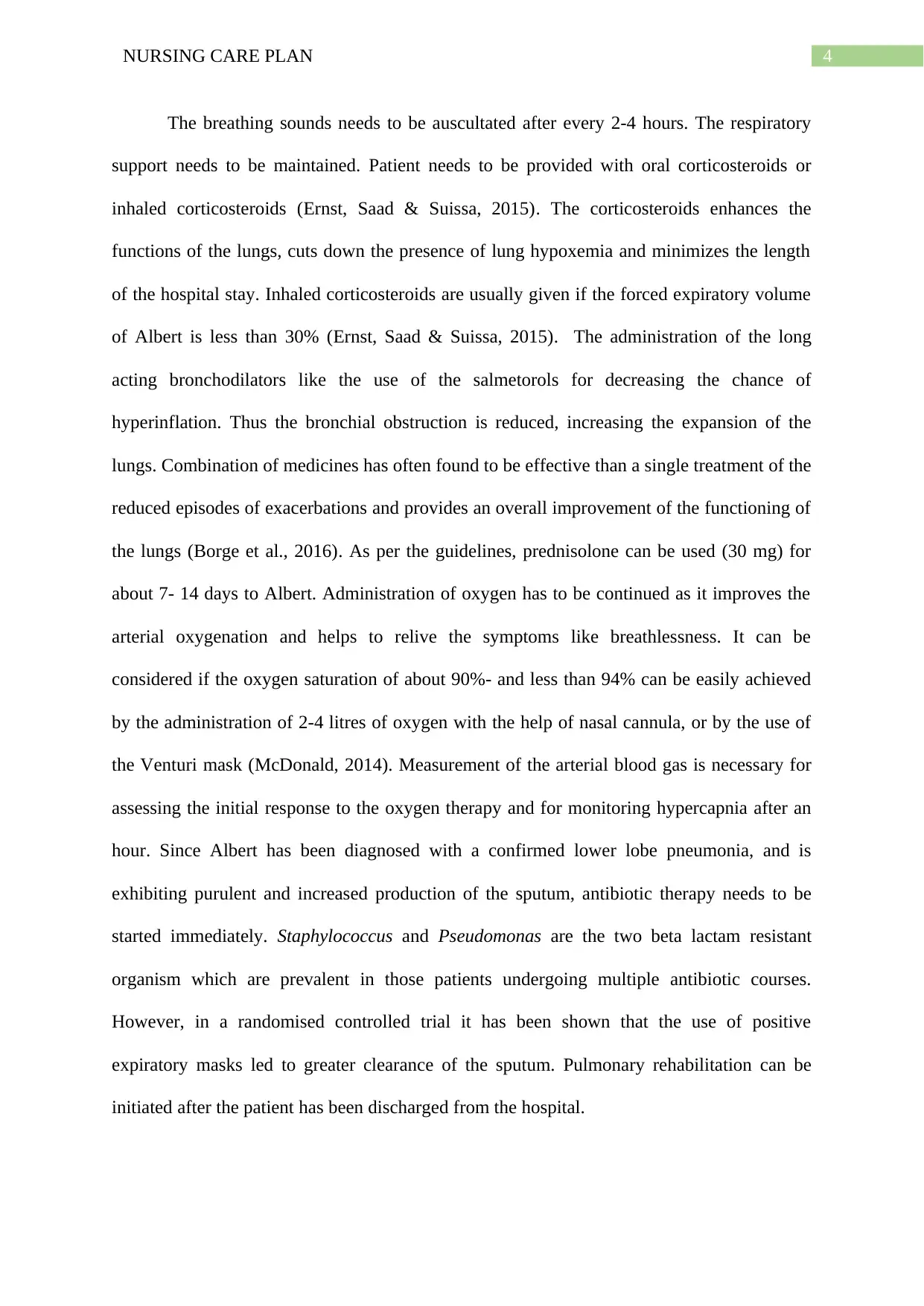
4NURSING CARE PLAN
The breathing sounds needs to be auscultated after every 2-4 hours. The respiratory
support needs to be maintained. Patient needs to be provided with oral corticosteroids or
inhaled corticosteroids (Ernst, Saad & Suissa, 2015). The corticosteroids enhances the
functions of the lungs, cuts down the presence of lung hypoxemia and minimizes the length
of the hospital stay. Inhaled corticosteroids are usually given if the forced expiratory volume
of Albert is less than 30% (Ernst, Saad & Suissa, 2015). The administration of the long
acting bronchodilators like the use of the salmetorols for decreasing the chance of
hyperinflation. Thus the bronchial obstruction is reduced, increasing the expansion of the
lungs. Combination of medicines has often found to be effective than a single treatment of the
reduced episodes of exacerbations and provides an overall improvement of the functioning of
the lungs (Borge et al., 2016). As per the guidelines, prednisolone can be used (30 mg) for
about 7- 14 days to Albert. Administration of oxygen has to be continued as it improves the
arterial oxygenation and helps to relive the symptoms like breathlessness. It can be
considered if the oxygen saturation of about 90%- and less than 94% can be easily achieved
by the administration of 2-4 litres of oxygen with the help of nasal cannula, or by the use of
the Venturi mask (McDonald, 2014). Measurement of the arterial blood gas is necessary for
assessing the initial response to the oxygen therapy and for monitoring hypercapnia after an
hour. Since Albert has been diagnosed with a confirmed lower lobe pneumonia, and is
exhibiting purulent and increased production of the sputum, antibiotic therapy needs to be
started immediately. Staphylococcus and Pseudomonas are the two beta lactam resistant
organism which are prevalent in those patients undergoing multiple antibiotic courses.
However, in a randomised controlled trial it has been shown that the use of positive
expiratory masks led to greater clearance of the sputum. Pulmonary rehabilitation can be
initiated after the patient has been discharged from the hospital.
The breathing sounds needs to be auscultated after every 2-4 hours. The respiratory
support needs to be maintained. Patient needs to be provided with oral corticosteroids or
inhaled corticosteroids (Ernst, Saad & Suissa, 2015). The corticosteroids enhances the
functions of the lungs, cuts down the presence of lung hypoxemia and minimizes the length
of the hospital stay. Inhaled corticosteroids are usually given if the forced expiratory volume
of Albert is less than 30% (Ernst, Saad & Suissa, 2015). The administration of the long
acting bronchodilators like the use of the salmetorols for decreasing the chance of
hyperinflation. Thus the bronchial obstruction is reduced, increasing the expansion of the
lungs. Combination of medicines has often found to be effective than a single treatment of the
reduced episodes of exacerbations and provides an overall improvement of the functioning of
the lungs (Borge et al., 2016). As per the guidelines, prednisolone can be used (30 mg) for
about 7- 14 days to Albert. Administration of oxygen has to be continued as it improves the
arterial oxygenation and helps to relive the symptoms like breathlessness. It can be
considered if the oxygen saturation of about 90%- and less than 94% can be easily achieved
by the administration of 2-4 litres of oxygen with the help of nasal cannula, or by the use of
the Venturi mask (McDonald, 2014). Measurement of the arterial blood gas is necessary for
assessing the initial response to the oxygen therapy and for monitoring hypercapnia after an
hour. Since Albert has been diagnosed with a confirmed lower lobe pneumonia, and is
exhibiting purulent and increased production of the sputum, antibiotic therapy needs to be
started immediately. Staphylococcus and Pseudomonas are the two beta lactam resistant
organism which are prevalent in those patients undergoing multiple antibiotic courses.
However, in a randomised controlled trial it has been shown that the use of positive
expiratory masks led to greater clearance of the sputum. Pulmonary rehabilitation can be
initiated after the patient has been discharged from the hospital.
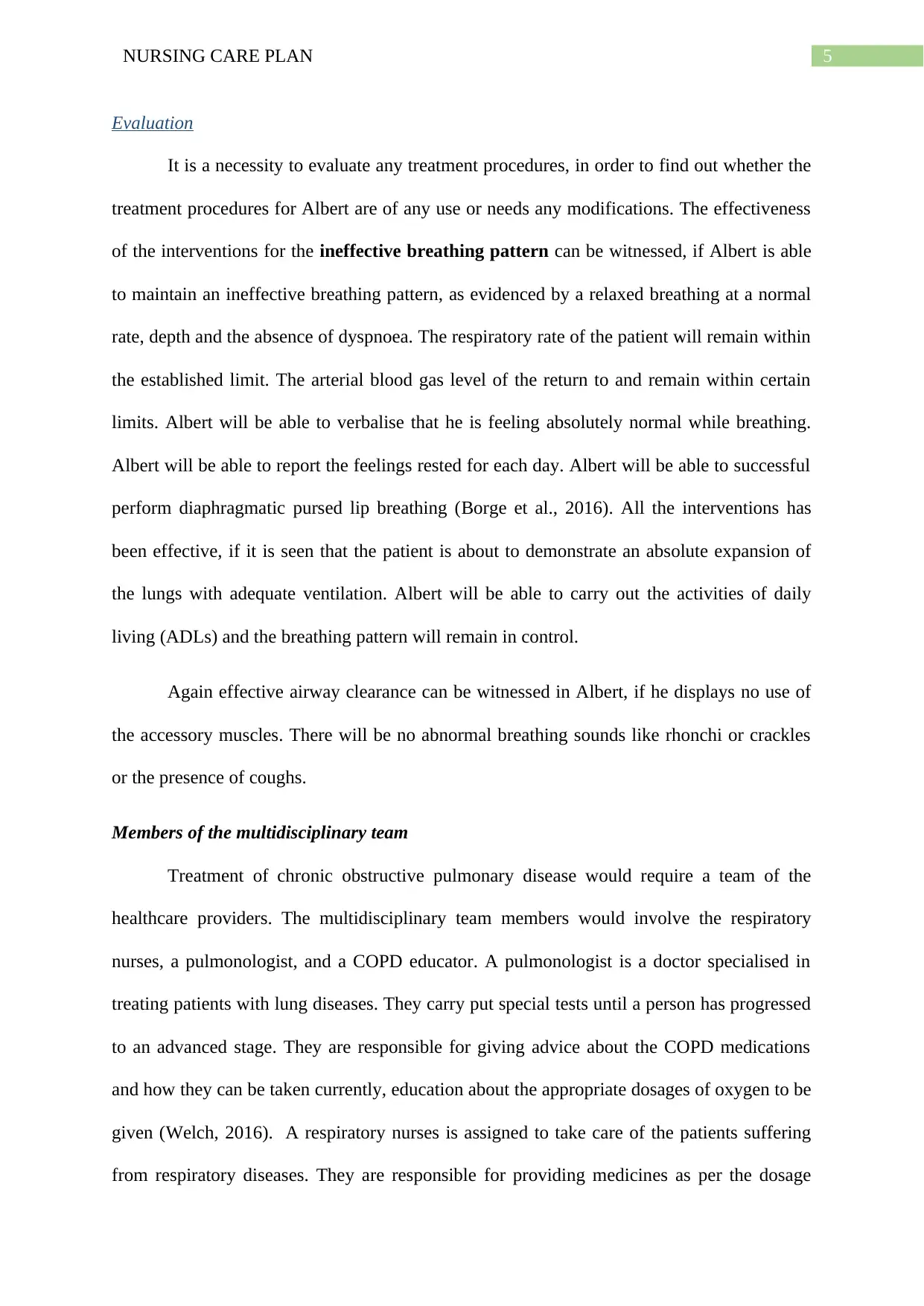
5NURSING CARE PLAN
Evaluation
It is a necessity to evaluate any treatment procedures, in order to find out whether the
treatment procedures for Albert are of any use or needs any modifications. The effectiveness
of the interventions for the ineffective breathing pattern can be witnessed, if Albert is able
to maintain an ineffective breathing pattern, as evidenced by a relaxed breathing at a normal
rate, depth and the absence of dyspnoea. The respiratory rate of the patient will remain within
the established limit. The arterial blood gas level of the return to and remain within certain
limits. Albert will be able to verbalise that he is feeling absolutely normal while breathing.
Albert will be able to report the feelings rested for each day. Albert will be able to successful
perform diaphragmatic pursed lip breathing (Borge et al., 2016). All the interventions has
been effective, if it is seen that the patient is about to demonstrate an absolute expansion of
the lungs with adequate ventilation. Albert will be able to carry out the activities of daily
living (ADLs) and the breathing pattern will remain in control.
Again effective airway clearance can be witnessed in Albert, if he displays no use of
the accessory muscles. There will be no abnormal breathing sounds like rhonchi or crackles
or the presence of coughs.
Members of the multidisciplinary team
Treatment of chronic obstructive pulmonary disease would require a team of the
healthcare providers. The multidisciplinary team members would involve the respiratory
nurses, a pulmonologist, and a COPD educator. A pulmonologist is a doctor specialised in
treating patients with lung diseases. They carry put special tests until a person has progressed
to an advanced stage. They are responsible for giving advice about the COPD medications
and how they can be taken currently, education about the appropriate dosages of oxygen to be
given (Welch, 2016). A respiratory nurses is assigned to take care of the patients suffering
from respiratory diseases. They are responsible for providing medicines as per the dosage
Evaluation
It is a necessity to evaluate any treatment procedures, in order to find out whether the
treatment procedures for Albert are of any use or needs any modifications. The effectiveness
of the interventions for the ineffective breathing pattern can be witnessed, if Albert is able
to maintain an ineffective breathing pattern, as evidenced by a relaxed breathing at a normal
rate, depth and the absence of dyspnoea. The respiratory rate of the patient will remain within
the established limit. The arterial blood gas level of the return to and remain within certain
limits. Albert will be able to verbalise that he is feeling absolutely normal while breathing.
Albert will be able to report the feelings rested for each day. Albert will be able to successful
perform diaphragmatic pursed lip breathing (Borge et al., 2016). All the interventions has
been effective, if it is seen that the patient is about to demonstrate an absolute expansion of
the lungs with adequate ventilation. Albert will be able to carry out the activities of daily
living (ADLs) and the breathing pattern will remain in control.
Again effective airway clearance can be witnessed in Albert, if he displays no use of
the accessory muscles. There will be no abnormal breathing sounds like rhonchi or crackles
or the presence of coughs.
Members of the multidisciplinary team
Treatment of chronic obstructive pulmonary disease would require a team of the
healthcare providers. The multidisciplinary team members would involve the respiratory
nurses, a pulmonologist, and a COPD educator. A pulmonologist is a doctor specialised in
treating patients with lung diseases. They carry put special tests until a person has progressed
to an advanced stage. They are responsible for giving advice about the COPD medications
and how they can be taken currently, education about the appropriate dosages of oxygen to be
given (Welch, 2016). A respiratory nurses is assigned to take care of the patients suffering
from respiratory diseases. They are responsible for providing medicines as per the dosage
⊘ This is a preview!⊘
Do you want full access?
Subscribe today to unlock all pages.

Trusted by 1+ million students worldwide
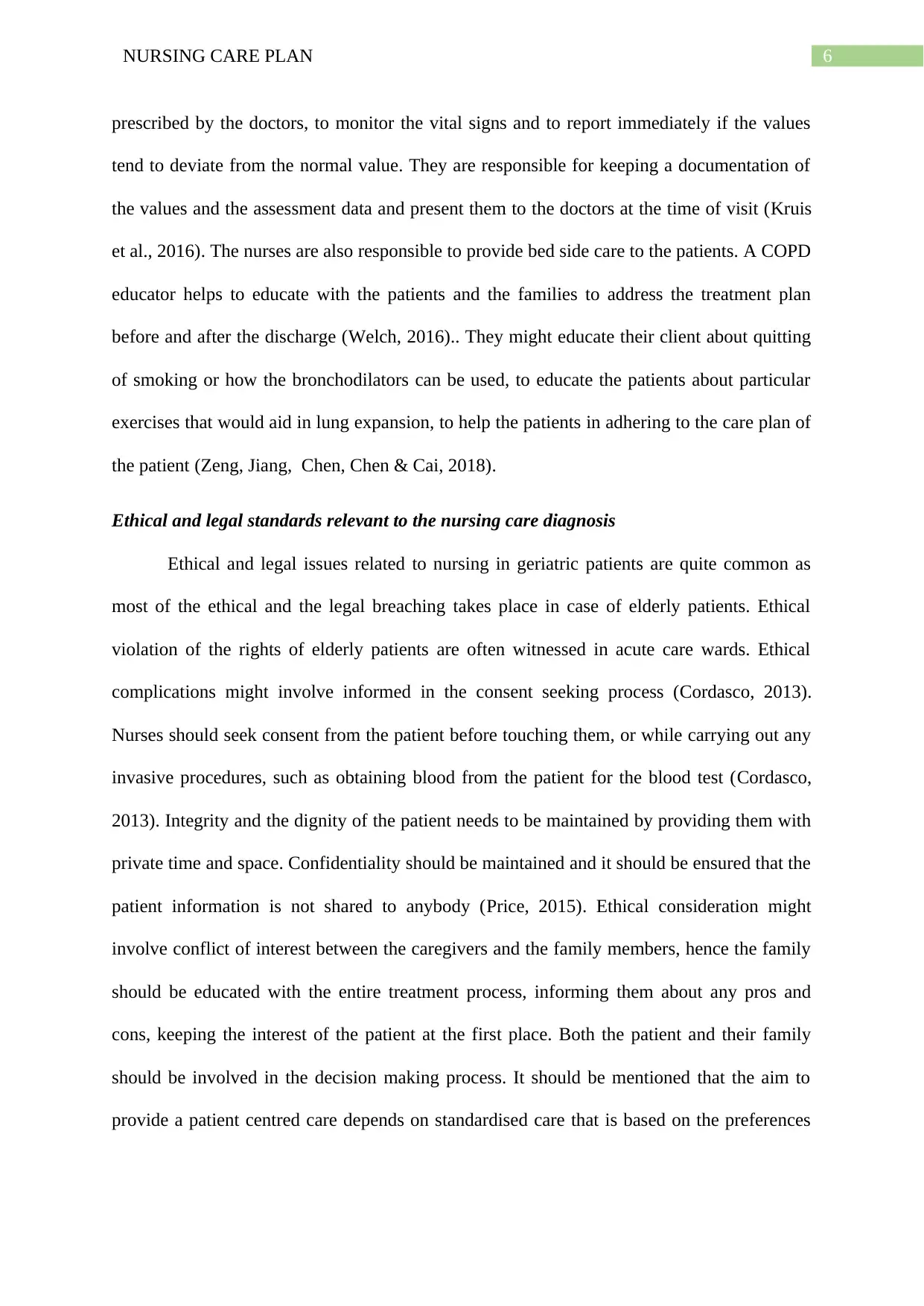
6NURSING CARE PLAN
prescribed by the doctors, to monitor the vital signs and to report immediately if the values
tend to deviate from the normal value. They are responsible for keeping a documentation of
the values and the assessment data and present them to the doctors at the time of visit (Kruis
et al., 2016). The nurses are also responsible to provide bed side care to the patients. A COPD
educator helps to educate with the patients and the families to address the treatment plan
before and after the discharge (Welch, 2016).. They might educate their client about quitting
of smoking or how the bronchodilators can be used, to educate the patients about particular
exercises that would aid in lung expansion, to help the patients in adhering to the care plan of
the patient (Zeng, Jiang, Chen, Chen & Cai, 2018).
Ethical and legal standards relevant to the nursing care diagnosis
Ethical and legal issues related to nursing in geriatric patients are quite common as
most of the ethical and the legal breaching takes place in case of elderly patients. Ethical
violation of the rights of elderly patients are often witnessed in acute care wards. Ethical
complications might involve informed in the consent seeking process (Cordasco, 2013).
Nurses should seek consent from the patient before touching them, or while carrying out any
invasive procedures, such as obtaining blood from the patient for the blood test (Cordasco,
2013). Integrity and the dignity of the patient needs to be maintained by providing them with
private time and space. Confidentiality should be maintained and it should be ensured that the
patient information is not shared to anybody (Price, 2015). Ethical consideration might
involve conflict of interest between the caregivers and the family members, hence the family
should be educated with the entire treatment process, informing them about any pros and
cons, keeping the interest of the patient at the first place. Both the patient and their family
should be involved in the decision making process. It should be mentioned that the aim to
provide a patient centred care depends on standardised care that is based on the preferences
prescribed by the doctors, to monitor the vital signs and to report immediately if the values
tend to deviate from the normal value. They are responsible for keeping a documentation of
the values and the assessment data and present them to the doctors at the time of visit (Kruis
et al., 2016). The nurses are also responsible to provide bed side care to the patients. A COPD
educator helps to educate with the patients and the families to address the treatment plan
before and after the discharge (Welch, 2016).. They might educate their client about quitting
of smoking or how the bronchodilators can be used, to educate the patients about particular
exercises that would aid in lung expansion, to help the patients in adhering to the care plan of
the patient (Zeng, Jiang, Chen, Chen & Cai, 2018).
Ethical and legal standards relevant to the nursing care diagnosis
Ethical and legal issues related to nursing in geriatric patients are quite common as
most of the ethical and the legal breaching takes place in case of elderly patients. Ethical
violation of the rights of elderly patients are often witnessed in acute care wards. Ethical
complications might involve informed in the consent seeking process (Cordasco, 2013).
Nurses should seek consent from the patient before touching them, or while carrying out any
invasive procedures, such as obtaining blood from the patient for the blood test (Cordasco,
2013). Integrity and the dignity of the patient needs to be maintained by providing them with
private time and space. Confidentiality should be maintained and it should be ensured that the
patient information is not shared to anybody (Price, 2015). Ethical consideration might
involve conflict of interest between the caregivers and the family members, hence the family
should be educated with the entire treatment process, informing them about any pros and
cons, keeping the interest of the patient at the first place. Both the patient and their family
should be involved in the decision making process. It should be mentioned that the aim to
provide a patient centred care depends on standardised care that is based on the preferences
Paraphrase This Document
Need a fresh take? Get an instant paraphrase of this document with our AI Paraphraser
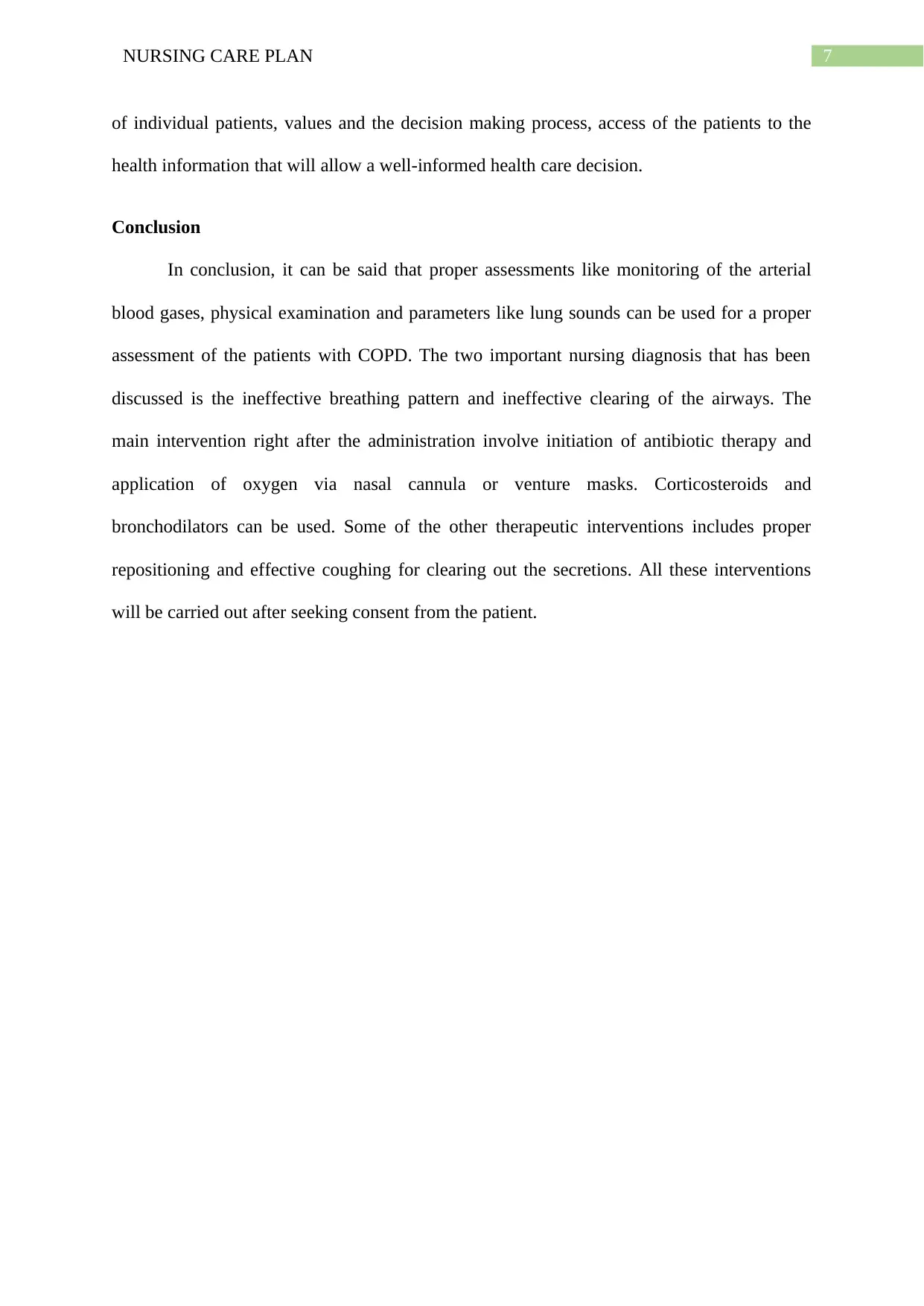
7NURSING CARE PLAN
of individual patients, values and the decision making process, access of the patients to the
health information that will allow a well-informed health care decision.
Conclusion
In conclusion, it can be said that proper assessments like monitoring of the arterial
blood gases, physical examination and parameters like lung sounds can be used for a proper
assessment of the patients with COPD. The two important nursing diagnosis that has been
discussed is the ineffective breathing pattern and ineffective clearing of the airways. The
main intervention right after the administration involve initiation of antibiotic therapy and
application of oxygen via nasal cannula or venture masks. Corticosteroids and
bronchodilators can be used. Some of the other therapeutic interventions includes proper
repositioning and effective coughing for clearing out the secretions. All these interventions
will be carried out after seeking consent from the patient.
of individual patients, values and the decision making process, access of the patients to the
health information that will allow a well-informed health care decision.
Conclusion
In conclusion, it can be said that proper assessments like monitoring of the arterial
blood gases, physical examination and parameters like lung sounds can be used for a proper
assessment of the patients with COPD. The two important nursing diagnosis that has been
discussed is the ineffective breathing pattern and ineffective clearing of the airways. The
main intervention right after the administration involve initiation of antibiotic therapy and
application of oxygen via nasal cannula or venture masks. Corticosteroids and
bronchodilators can be used. Some of the other therapeutic interventions includes proper
repositioning and effective coughing for clearing out the secretions. All these interventions
will be carried out after seeking consent from the patient.
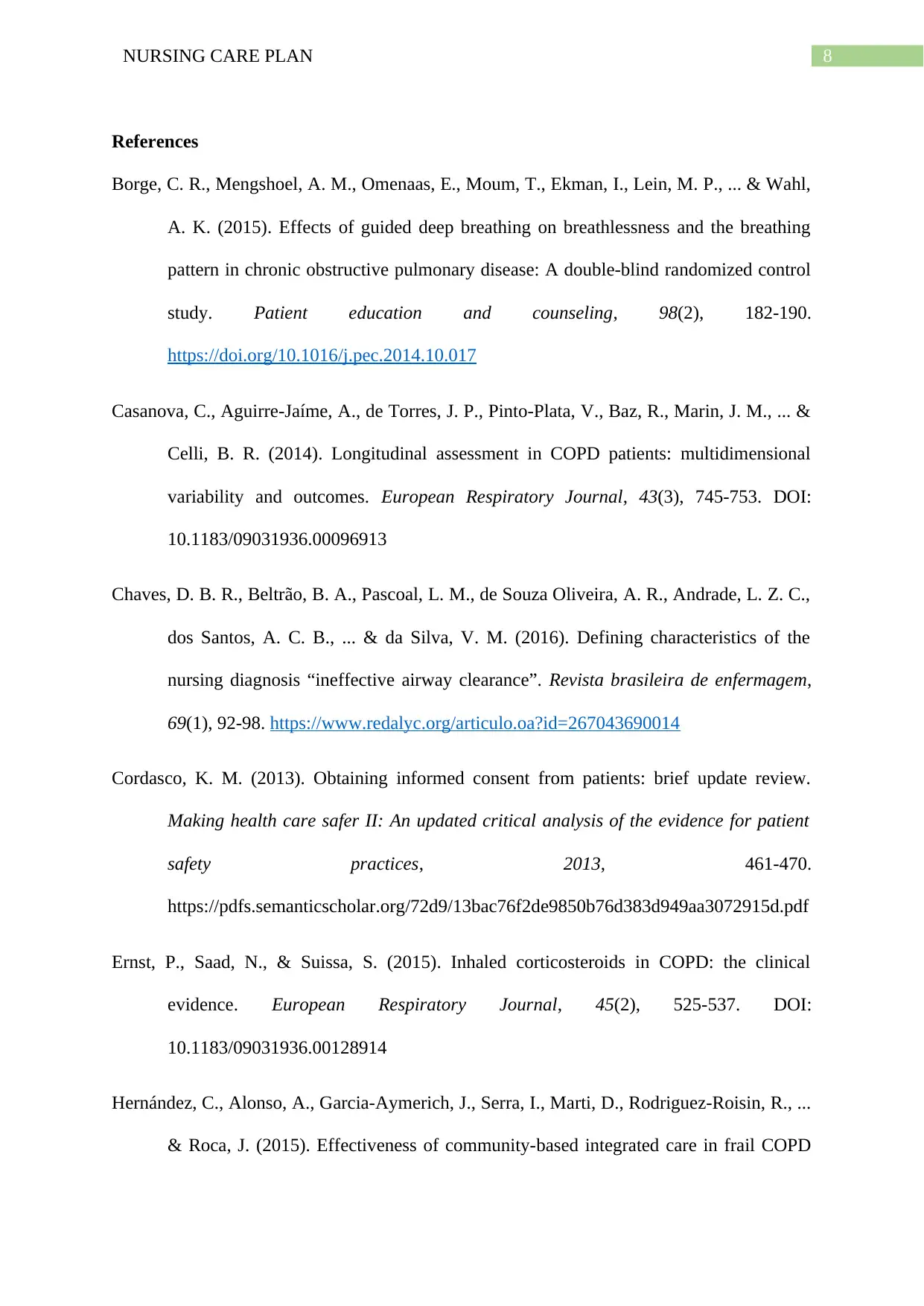
8NURSING CARE PLAN
References
Borge, C. R., Mengshoel, A. M., Omenaas, E., Moum, T., Ekman, I., Lein, M. P., ... & Wahl,
A. K. (2015). Effects of guided deep breathing on breathlessness and the breathing
pattern in chronic obstructive pulmonary disease: A double-blind randomized control
study. Patient education and counseling, 98(2), 182-190.
https://doi.org/10.1016/j.pec.2014.10.017
Casanova, C., Aguirre-Jaíme, A., de Torres, J. P., Pinto-Plata, V., Baz, R., Marin, J. M., ... &
Celli, B. R. (2014). Longitudinal assessment in COPD patients: multidimensional
variability and outcomes. European Respiratory Journal, 43(3), 745-753. DOI:
10.1183/09031936.00096913
Chaves, D. B. R., Beltrão, B. A., Pascoal, L. M., de Souza Oliveira, A. R., Andrade, L. Z. C.,
dos Santos, A. C. B., ... & da Silva, V. M. (2016). Defining characteristics of the
nursing diagnosis “ineffective airway clearance”. Revista brasileira de enfermagem,
69(1), 92-98. https://www.redalyc.org/articulo.oa?id=267043690014
Cordasco, K. M. (2013). Obtaining informed consent from patients: brief update review.
Making health care safer II: An updated critical analysis of the evidence for patient
safety practices, 2013, 461-470.
https://pdfs.semanticscholar.org/72d9/13bac76f2de9850b76d383d949aa3072915d.pdf
Ernst, P., Saad, N., & Suissa, S. (2015). Inhaled corticosteroids in COPD: the clinical
evidence. European Respiratory Journal, 45(2), 525-537. DOI:
10.1183/09031936.00128914
Hernández, C., Alonso, A., Garcia-Aymerich, J., Serra, I., Marti, D., Rodriguez-Roisin, R., ...
& Roca, J. (2015). Effectiveness of community-based integrated care in frail COPD
References
Borge, C. R., Mengshoel, A. M., Omenaas, E., Moum, T., Ekman, I., Lein, M. P., ... & Wahl,
A. K. (2015). Effects of guided deep breathing on breathlessness and the breathing
pattern in chronic obstructive pulmonary disease: A double-blind randomized control
study. Patient education and counseling, 98(2), 182-190.
https://doi.org/10.1016/j.pec.2014.10.017
Casanova, C., Aguirre-Jaíme, A., de Torres, J. P., Pinto-Plata, V., Baz, R., Marin, J. M., ... &
Celli, B. R. (2014). Longitudinal assessment in COPD patients: multidimensional
variability and outcomes. European Respiratory Journal, 43(3), 745-753. DOI:
10.1183/09031936.00096913
Chaves, D. B. R., Beltrão, B. A., Pascoal, L. M., de Souza Oliveira, A. R., Andrade, L. Z. C.,
dos Santos, A. C. B., ... & da Silva, V. M. (2016). Defining characteristics of the
nursing diagnosis “ineffective airway clearance”. Revista brasileira de enfermagem,
69(1), 92-98. https://www.redalyc.org/articulo.oa?id=267043690014
Cordasco, K. M. (2013). Obtaining informed consent from patients: brief update review.
Making health care safer II: An updated critical analysis of the evidence for patient
safety practices, 2013, 461-470.
https://pdfs.semanticscholar.org/72d9/13bac76f2de9850b76d383d949aa3072915d.pdf
Ernst, P., Saad, N., & Suissa, S. (2015). Inhaled corticosteroids in COPD: the clinical
evidence. European Respiratory Journal, 45(2), 525-537. DOI:
10.1183/09031936.00128914
Hernández, C., Alonso, A., Garcia-Aymerich, J., Serra, I., Marti, D., Rodriguez-Roisin, R., ...
& Roca, J. (2015). Effectiveness of community-based integrated care in frail COPD
⊘ This is a preview!⊘
Do you want full access?
Subscribe today to unlock all pages.

Trusted by 1+ million students worldwide
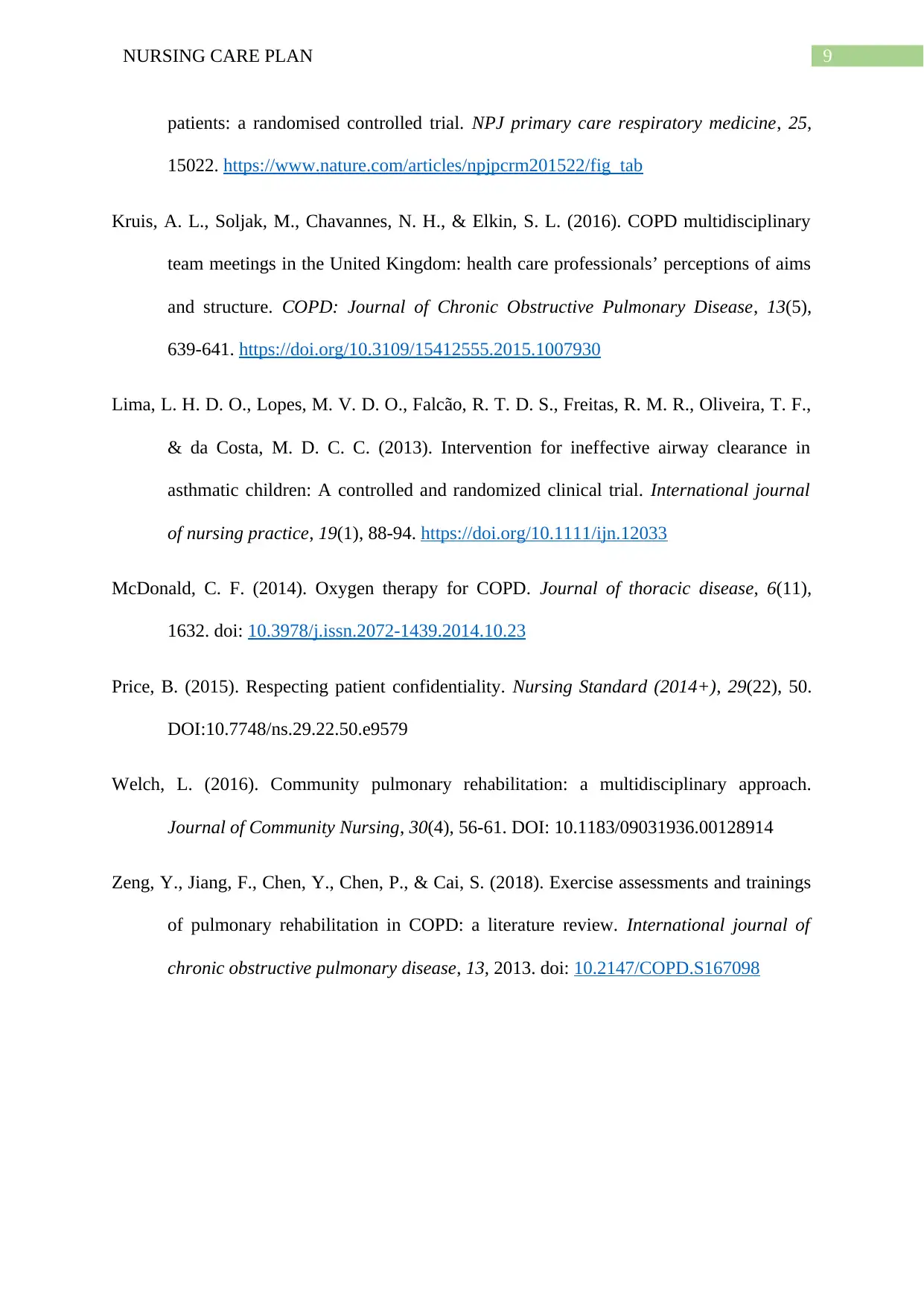
9NURSING CARE PLAN
patients: a randomised controlled trial. NPJ primary care respiratory medicine, 25,
15022. https://www.nature.com/articles/npjpcrm201522/fig_tab
Kruis, A. L., Soljak, M., Chavannes, N. H., & Elkin, S. L. (2016). COPD multidisciplinary
team meetings in the United Kingdom: health care professionals’ perceptions of aims
and structure. COPD: Journal of Chronic Obstructive Pulmonary Disease, 13(5),
639-641. https://doi.org/10.3109/15412555.2015.1007930
Lima, L. H. D. O., Lopes, M. V. D. O., Falcão, R. T. D. S., Freitas, R. M. R., Oliveira, T. F.,
& da Costa, M. D. C. C. (2013). Intervention for ineffective airway clearance in
asthmatic children: A controlled and randomized clinical trial. International journal
of nursing practice, 19(1), 88-94. https://doi.org/10.1111/ijn.12033
McDonald, C. F. (2014). Oxygen therapy for COPD. Journal of thoracic disease, 6(11),
1632. doi: 10.3978/j.issn.2072-1439.2014.10.23
Price, B. (2015). Respecting patient confidentiality. Nursing Standard (2014+), 29(22), 50.
DOI:10.7748/ns.29.22.50.e9579
Welch, L. (2016). Community pulmonary rehabilitation: a multidisciplinary approach.
Journal of Community Nursing, 30(4), 56-61. DOI: 10.1183/09031936.00128914
Zeng, Y., Jiang, F., Chen, Y., Chen, P., & Cai, S. (2018). Exercise assessments and trainings
of pulmonary rehabilitation in COPD: a literature review. International journal of
chronic obstructive pulmonary disease, 13, 2013. doi: 10.2147/COPD.S167098
patients: a randomised controlled trial. NPJ primary care respiratory medicine, 25,
15022. https://www.nature.com/articles/npjpcrm201522/fig_tab
Kruis, A. L., Soljak, M., Chavannes, N. H., & Elkin, S. L. (2016). COPD multidisciplinary
team meetings in the United Kingdom: health care professionals’ perceptions of aims
and structure. COPD: Journal of Chronic Obstructive Pulmonary Disease, 13(5),
639-641. https://doi.org/10.3109/15412555.2015.1007930
Lima, L. H. D. O., Lopes, M. V. D. O., Falcão, R. T. D. S., Freitas, R. M. R., Oliveira, T. F.,
& da Costa, M. D. C. C. (2013). Intervention for ineffective airway clearance in
asthmatic children: A controlled and randomized clinical trial. International journal
of nursing practice, 19(1), 88-94. https://doi.org/10.1111/ijn.12033
McDonald, C. F. (2014). Oxygen therapy for COPD. Journal of thoracic disease, 6(11),
1632. doi: 10.3978/j.issn.2072-1439.2014.10.23
Price, B. (2015). Respecting patient confidentiality. Nursing Standard (2014+), 29(22), 50.
DOI:10.7748/ns.29.22.50.e9579
Welch, L. (2016). Community pulmonary rehabilitation: a multidisciplinary approach.
Journal of Community Nursing, 30(4), 56-61. DOI: 10.1183/09031936.00128914
Zeng, Y., Jiang, F., Chen, Y., Chen, P., & Cai, S. (2018). Exercise assessments and trainings
of pulmonary rehabilitation in COPD: a literature review. International journal of
chronic obstructive pulmonary disease, 13, 2013. doi: 10.2147/COPD.S167098
Paraphrase This Document
Need a fresh take? Get an instant paraphrase of this document with our AI Paraphraser

10NURSING CARE PLAN
1 out of 11
Related Documents
Your All-in-One AI-Powered Toolkit for Academic Success.
+13062052269
info@desklib.com
Available 24*7 on WhatsApp / Email
![[object Object]](/_next/static/media/star-bottom.7253800d.svg)
Unlock your academic potential
Copyright © 2020–2025 A2Z Services. All Rights Reserved. Developed and managed by ZUCOL.




